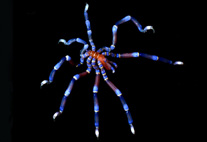Abstract
Hoplitis bees of the Palaearctic subgenus Stenosmia (Megachilidae) inhabit deserts and semideserts between southern Spain and eastern Asia. They nest in excavated burrows in the soil and collect pollen from plant taxa that typically grow in desert areas, such as Frankenia (Frankeniaceae), Peganum (Nitrariaceae), Tamarix (Tamaricaceae) or Zygophyllum (Zygophyllaceae). The taxonomic revision of the subgenus Stenosmia revealed the existence of four undescribed species: Hoplitis desertorum spec. nov. from the Levant, H. crassipunctata spec. nov. and H. dispersipunctata spec. nov. from Central Asia, and H. gobiensis spec. nov. from the Gobi desert. Hoplitis denticulata (Zanden, 1992) is synonymized with H. jordanica (Warncke, 1991), and Hoplitis xinjiangense (Wu, 2004), formerly considered a H. (Stenosmia) species, is removed from this subgenus. The type species of the subgenus Stenosmia Michener is fixed as H. crassipunctata spec. nov., which has been misidentified as H. flavicornis (Morawitz, 1877). Keys for the identification of the H. (Stenosmia) species are given.

